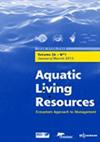卫星图像分析揭示了越南Van Phong湾海草床在过去30年里的变化
IF 1.5
4区 农林科学
Q3 FISHERIES
引用次数: 18
摘要
海草草甸是海岸带脆弱的生态系统。自然灾害、土地开垦和各种人类活动似乎对越南海草床的分布和生物性能产生了负面影响。本研究采用TM/OLI卫星Landsat影像分析方法,对越南Van Phong湾海草分布的变化进行了分析。采用最大似然决策规则提取海草床分布数据。利用原位参考数据进行HLM图像分类的误差矩阵准确率为81 ~ 95%,Kappa系数在0.72 ~ 0.91之间。结果显示,在过去三十年,云丰湾原有海草床的面积减少了186.2公顷(或35.8%),每个特定地点的减少可能是由于不同的原因造成的。台风可能造成公海地点海草床的损失,而水产养殖活动、挖掘和陆源破坏可能造成受保护地点海草床的损失。本文章由计算机程序翻译,如有差异,请以英文原文为准。
Satellite image analysis reveals changes in seagrass beds at Van Phong Bay, Vietnam during the last 30 years
Seagrass meadows are fragile ecosystems in the coastal zone. Natural disasters, land reclamation and various human activities seem to exert negative impacts on the distribution and biological performance of seagrass beds in Vietnam. In this present study, satellite Landsat TM/OLI image analysis was applied to determine changes in seagrass distribution at Van Phong Bay, Vietnam in the last 30 years. The maximum likelihood decision rule was used to extract seagrass bed distribution data. The error matrix using the in situ reference data for HLM image classification was 81–95% accurate, and Kappa coefficients were between 0.72 and 0.91. The results indicated that 186.2 ha (or 35.8%) of the original seagrass beds were lost in the last three decades at Van Phong Bay, and decline in each specific site may have been due to different causes. Typhoons may have caused the loss of seagrass beds at open-sea sites whereas aquaculture activities, excavation and terrigenous obliteration may have caused such losses in protected sites.
求助全文
通过发布文献求助,成功后即可免费获取论文全文。
去求助
来源期刊

Aquatic Living Resources
农林科学-海洋与淡水生物学
CiteScore
2.30
自引率
0.00%
发文量
10
审稿时长
>24 weeks
期刊介绍:
Aquatic Living Resources publishes original research papers, review articles and propective notes dealing with all exploited (i.e. fished or farmed) living resources in marine, brackish and freshwater environments.
Priority is given to ecosystem-based approaches to the study of fishery and aquaculture social-ecological systems, including biological, ecological, economic and social dimensions.
Research on the development of interdisciplinary methods and tools which can usefully support the design, implementation and evaluation of alternative management strategies for fisheries and/or aquaculture systems at different scales is particularly welcome by the journal. This includes the exploration of scenarios and strategies for the conservation of aquatic biodiversity and research relating to the development of integrated assessment approaches aimed at ensuring sustainable and high quality uses of aquatic living resources.
 求助内容:
求助内容: 应助结果提醒方式:
应助结果提醒方式:


